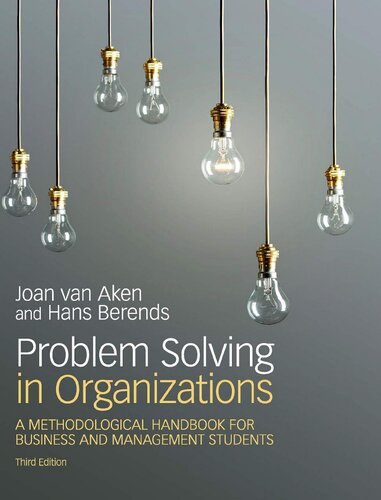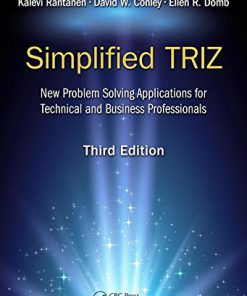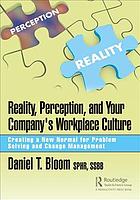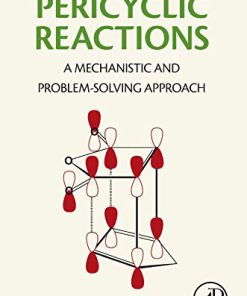Problem Solving in Organizations A Methodological Handbook for Business and Management Students 3rd Edition by Joan Ernst Van Aken ISBN 1108402771 978-1108402774
$50.00 Original price was: $50.00.$25.00Current price is: $25.00.
Problem Solving in Organizations: A Methodological Handbook for Business and Management Students 3rd Edition by Joan Ernst Van Aken – Ebook PDF Instant Download/Delivery: 1108402771, 978-1108402774
Full download Problem Solving in Organizations: A Methodological Handbook for Business and Management Students 3rd Edition after payment

Product details:
ISBN 10: 1108402771
ISBN 13: 978-1108402774
Author: Joan Ernst Van Aken
An indispensable guide enabling business and management students to develop their professional competences in real organizational settings, this new and fully updated edition of Problem Solving in Organizations equips the reader with the necessary toolkit to apply the theory to practical business problems. By encouraging the reader to use the theory and showing them how to do so in a fuzzy, ambiguous and politically charged, real-life organizational context, this book offers a concise introduction to design-oriented and theory-informed problem solving in organizations. In addition, it gives support for designing the overall approach to a problem-solving project as well as support for each of the steps of the problem-solving cycle: problem definition, problem analysis, solution design, interventions, and evaluation. Problem Solving in Organizations is suitable for readers with a wide range of learning objectives, including undergraduates and graduates studying business and management, M.B.A students and professionals working in organizations.
Table of contents:
Part I Introduction
1. Scope And Nature Of This Handbook
1.1 Objectives And Target Audiences
1.2 Design-Oriented And Theory-Informed Problem Solving In Organizations
1.3 How To Use This Handbook
2. Types Of Student Projects
2.1 Introduction
2.2 Two Basic Process Structures
2.3 Three Knowledge-Generating Research Processes
2.4 Problems Caused By Mixing Different Process Types
2.5 Concluding Remarks
3. Problem-Solving Projects
3.1 Introduction
3.2 Rational Problem Solving
3.3 Problem-Solving Strategies
3.4 Theory-Informed Field Problem Solving
3.5 The Application Domain Of Design-Oriented And Theory-Informed Problem Solving
3.6 The Nature Of Field Problem-Solving Projects
3.7 The Basic Set-Up Of A Field Problem-Solving Project
3.8 Problem-Solving Projects In Different Execution Modes
3.9 Characteristics Of Good Field Problem-Solving Projects
3.10 Concluding Remarks
Part II The Problem-Solving Project
4. Intake And Problem Definition
4.1 Introduction
4.2 Intake And External Exploration
4.3 Internal Orientation And Problem Definition
4.4 Project Design
4.5 Project Proposal
4.6 Example
4.7 Concluding Remarks
5. Theory-Informed Diagnosis Of Business Problems
5.1 Introduction
5.2 Modelling Business Processes And Systems
5.3 Analysis Of The Business Problem And Its Causes
5.4 Theoretical Grounding
5.5 Example: EcoLogic
5.6 Integrating The Diagnostic Story
5.7 Alternative Approaches
5.8 Concluding Remarks: From Diagnosis To Redesign
6. Solution Design
6.1 Introduction
6.2 The Role Of The Solution Design
6.3 The Overall Solution Design Process
6.4 Synthesis–Evaluation Iterations
6.5 Solution Validation: The Concluding Evaluation
6.6 Solution Design: The IIS Case
6.7 Concluding Remarks
7. Change Plan Design And The Change Process
7.1 The Timing Of Change Plan Design
7.2 Change Plan Design
7.3 The Actual Change Process
7.4 Change Plan Design: The IIS Case
7.5 The Importance Of Developing Organizational Support
7.6 Concluding Remarks
8. Evaluation, Learning And Project Termination
8.1 Introduction
8.2 Project-Oriented Evaluation
8.3 Learning For The Future
8.4 Scientific Reflection
8.5 Personal And Professional Development
8.6 Project Termination And Reporting
8.7 Concluding Remarks
Part III Methods
9. Qualitative Research Methods
9.1 Qualitative Versus Quantitative
9.2 Unit Of Analysis
9.3 Sampling And Case Selection
9.4 Qualitative Data-Collection Methods
9.5 Qualitative Methods Of Analysis
9.6 Concluding Remarks
10. Searching And Using Scholarly Literature
10.1 Introduction
10.2 Types Of Publication
10.3 Focusing A Literature Review
10.4 Searching The Literature
10.5 Integrating Ideas And Findings
10.6 Concluding Remarks
11. Quality Criteria For Research
11.1 Introduction
11.2 Controllability
11.3 Reliability
11.4 Validity
11.5 Recognition Of Results
11.6 Concluding Remarks
Part IV Designs, Designing And Design Science Research
12. Designs And Designing
12.1 Introduction
12.2 Designing Material Artefacts: Designs And Designing
12.3 Designing Material Artefacts: The Overall Design Process
12.4 The Design Of Material Artefacts: Synthesis–Evaluation Iterations
12.5 The Design Of Material Artefacts: Minimal Specification And Hidden Properties
12.6 Social System Design
12.7 Paradigmatic Starting Points In Social System Design
12.8 Concluding Remarks
13. Design Science Research: Developing Generic Solutions For Field Problems
13.1 Introduction
13.2 The Key Methodological Problem In Developing Generic Solutions
13.3 A Learning Strategy For Developing Generic Solutions
13.4 Key Characteristics Of Design Science Research
13.5 Using Generic Solutions In The Swamp Of Practice: Evidence-Based Practice
13.6 Operational Issues In Conducting Design Science Research
13.7 Concluding Remarks
Part V Cases
14. Cases
14.1 Introduction
14.2 The Assignment: Make A Project Proposal
14.3 Six Cases
People also search for:
problem solving in organizations van aken
problem solving in organizations van aken pdf
problem solving techniques in organizations
importance of problem solving and decision making in organizations
problem-solution organization example
Tags: Joan Ernst Van Aken, Problem Solving, Organizations, Methodological Handbook, Business, Management Students
You may also like…
Business & Economics - Management & Leadership
Education Studies & Teaching
Problem Solving in Mathematics Education 1st Edition Peter Liljedahl
Business & Economics - Management & Leadership
Business & Economics - Personal Finance
Financial Management for Nonprofit Organizations: Policies and Practices 3rd Edition John Zietlow
Education Studies & Teaching - School Education & Teaching
Chemistry - Organic Chemistry
Medicine
Problem Solving Questions in Toxicology A Study Guide for the Board and other Examinations P K Gupta
Engineering












